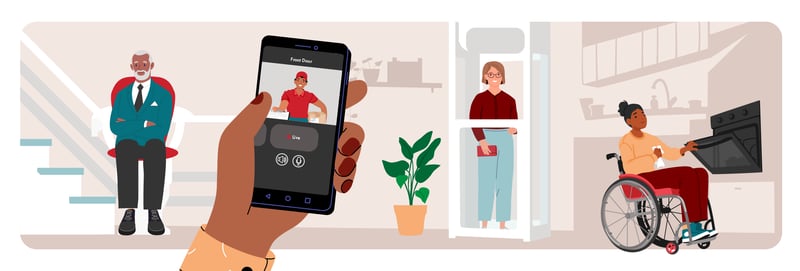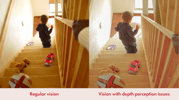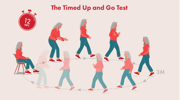
If you’re looking to make home adaptations for disabled or elderly people, it’s important to consider costs. Read our breakdown and tips here.
As we age, our needs change, and this may include home adaptations to make it easier to live independently, even with impaired mobility.
Home adaptations are the changes you can make to your own home to make it easier, safer and more comfortable to live there as your needs change. 96% of people in the UK aged over 75 say that they would prefer to remain living independently, which doesn't surprise us. We understand that leaving your home to move somewhere new shouldn't be your only option; instead, we want to help you stay longer in your forever home surrounded by comfort and familiarity.
That's why we've put together the cost of home adaptations for disabled or older people with limited mobility, what these changes to your home might look like depending on your needs and how you can receive financial help for these home adaptations from local authorities.
In this article, we'll explore:
- Our recommended home improvements for physically disabled people
- The costs of these home adaptations
- Useful information on grants for adaptations
What are the benefits of home adaptations for physically disabled people?
As well as ensuring you can remain in your own home, the number one benefit of making housing adaptations is to maintain safety, which gives both you and your loved ones peace of mind. Adaptations like grab rails to hold onto or a wet room bathroom without awkward ledges to step over can minimise the risk of injury and keep you living independently for longer.
For wheelchair users, widening doors means you can move from room to room with ease and lowering kitchen worktops allows you to use kitchen equipment safely with improved visibility.
Top recommended home adaptations:
Just 3.4% (740,000) of homes in the UK have the four recommended features for someone with mobility problems (level access, flush threshold, WC at entry level, circulation space). An occupational therapy assessment can also help steer the home improvements and adaptations you need.
Here are the most important considerations when adapting your home for limited mobility:
- Level access - No steps, steep inclines, or other obstacles in the way throughout the space
- Flush threshold - A seamless transition between one room or another i.e no raised lip between doorways which could hinder a wheelchair user
- WC at entry level - A wheelchair-accessible bathroom on the ground floor of a property so steps or stairs don't need to be navigated to use the facilities
- Circulation space - Enough space in an area for a wheelchair user to comfortably use as a 365-degree turning circle without obstruction.
Home adaptations and their average costs
To make day-to-day life easier, we recommend making the following adaptations - even if just some small aids - to ensure you are still able to carry out everyday tasks with ease. We've found the average costs of the most common home adaptations to help you budget any changes needed.
- Setting up a smart home hub £90
- Installing a video doorbell £180
- Swapping regular lamps for touch lamps £70
- Using a garden tool trolley outside £80
- Adding a bath seat £50
- Plugging in nightlights £20
- Adding power-reclining chairs £900
- Adding an adjustable bed £900
- Installing grab rails £40
- Lowering kitchen worktops £6,000
- Raising plant beds £200
- Installing a stairlift or home lift £4,000 or £15,000 respectively
- Installing a boiling water dispenser £65
- Downstairs bathroom fitted £8,000
- Installing a bath with a door £3,000
- Installing ramps £350
- Automatic door openers £800
- Adjusting outlet height £300
- Widening doors £700

How much do these home adaptations cost in total?
We've calculated the average cost of adapting your home with these changes above to be:
- £27,845 if renovations include a stairlift
- or £38,845 if opting for the more advanced home lift.
The cost of a stairlift starts at £2,510 (reconditioned), or from £5,635 for a stairlift which incorporates turns in a staircase.
Everybody's needs are different, and all these adaptations may not be necessary. We recommend thinking about what your priority needs are first and then deciding which adaptations are the most important for your household – that’s where the support of loved ones or an occupational therapist will come in handy.
Home adaptations: examples and how they help
Designed to aid with everyday tasks which may have become difficult for someone physically disabled, each of these adaptations can make daily life simpler in different ways.
Small home adaptations
Small adaptations usually consist of appliances and items among other ways to make everyday living easier.
These can include:
- Smart home hub
A smart home hub allows your home devices, such as lighting controls, heating systems, cameras and sensors, to be integrated into one central 'brain' in the home instead of from each device individually.
Plus, you can set up automatic commands such as turning on the heating system or lighting controls at a certain time of day to make the task easier with a disability.
A great feature of smart home technology is voice activation - meaning easy controls for things like heating or security systems.
- Video doorbell
If you struggle to get to the front door for visitors, a video doorbell could be a useful adaptation. It combines a traditional doorbell with a video link to your phone or tablet so you can see who is at your front door without needing to physically go to answer it.
- Touch lamps
These are a great way to make a small change to the lighting in your home, especially if changes to your fine motor skills make it harder to switch lights on and off.
Touch lamps allow you to adjust the lighting level as well as turning lights on and off simply by touching the base of the lamp, instead of fumbling around for the switch.
- Garden tool trolleys
If you enjoy spending time in the garden, introduce a garden tool trolley to have everything you need at hand. This way, you don't have to go back and forth to the shed or greenhouse to hunt for things you need.
- Shower stool
Use a shower stool to sit on while showering so you don't lose your balance under the running water. This allows you to bathe as usual without the danger of falling and injuring yourself.
- Night Lights
You can plug nightlights into outlets so it's easier to see if you need to get up during the night. Some nightlights turn on automatically as they detect movement, so you don't have to bend down to switch them on and off. If you struggle to see areas around the house clearly, nightlights prove an easy solution.
- Power-reclining chairs and adjustable bed
You can also introduce power-reclining chairs and an adjustable bed for help with sitting, lying down and standing up again.
These chairs and beds can change the angle of recline with the touch of a button, which means if you struggle with mobility, you can easily adjust your position. It can make a world of difference to how long it takes you to get out of bed in the morning or get up from a chair.
Larger home adaptations
Depending on your needs, you may need to make larger changes to your home which may require building work. Although the work may interrupt your daily routine for a little while, the benefits of the completed changes to your home can be life-changing - especially if your mobility continues to decline.
Larger adaptations can include:
- Stairlift or home lift
One of the most helpful home adaptations you can make is installing a stairlift or home lift. If you struggle moving between the floors of your home, a stairlift or home lift takes all the effort out for you.
A stairlift fits to your existing staircase, regardless of whether it goes straight up or curves around, and the chair simply carries you safely up to the next floor. You also have the option of a home lift which takes you directly through the floors of your house.
- Grab rails
Installed into the wall of your home near the toilet or bathtub, for example, install grab rails in places where you might need support when moving from a sitting to a standing position, or where you need support to travel further distances in the home.
You can install a grab rail horizontally or vertically, depending on its purpose. A horizontal position allows you to rest your forearms on it as you go up the stairs or stand in the shower, for example, while a vertical grab rail can help you move from sitting to standing without your hand slipping.
- Wider doorways
For improved wheelchair access around the home, widen doors so a wheelchair can easily pass through.
- Automatic door openers
Install sensors near doorways to allow for doors to open automatically. This means less struggling to turn door handles or awkwardly reaching for the door. Instead, sensors detect movement and save valuable time and effort.
- Access ramps
Installing ramps to replace steps allows for easier access in and out of your home, especially for wheelchair users. This removes any steps that may be unsafe for a disabled person.
- Lowered work surfaces
If you're a wheelchair user or struggle to stand up for longer periods of time, consider lowering your kitchen work surfaces. This way, you can reach while preparing meals and use the space safely, as you'll have better visibility from a lower height.
- Pull-out shelves
Hinged doors on cabinets, such as in the kitchen, can prove pesky for wheelchair users. Consider switching to pull-out shelves as they require less awkward maneuvering.
- Boiling water dispenser
Boiling water dispensers are easier - and safer - to use than a kettle as you don't have to lift and pour. They are designed to be DDA (Disability Discrimination Act) complaint, with safety features to reduce risk.
A boiling water dispenser can be either a tabletop or an integrated system - the difference is that a tabletop dispenser will need refilling, whereas an integrated dispenser replenishes itself.
- Downstairs bathroom or wet room
Adapting a downstairs room or adding an extension to accommodate a fitted bathroom allows you to use the toilet, sink, bath and/or shower if you struggle to get up and down the stairs.
Fitting a bathroom downstairs allows for more customisation, such as widening doorways and a roll-in shower for wheelchair users.
- Bath with door
With an integrated door, an adapted bath removes the need to swing your leg over the side of it to get out, especially if you have hip or joint issues. Water and soap residue on the bottom of the bath can cause it to be slippery, and lifting your leg over can put you at risk of falling, whereas a bath with a door helps prevent this.
- Raised plant beds
For people with green fingers, raising your plant beds can help you maintain your vegetable patch even with mobility issues. You won't have to bend down to tend to your plants, saving yourself a back injury.
- Accessible power outlets
Most power outlets are located close to skirting boards throughout the home, making plugging in electrical appliances challenging for disabled people and wheelchair users. Considering altering the height of outlets to be closer to waist level to avoid bending down to access them.

Do I need to be assessed first to make home adaptations?
If you need to adapt your home to accommodate your needs, you can request a free assessment from a social worker or occupational therapist via your local authority.
An occupational therapist from your local council will visit you for a home assessment and discuss your mobility. They will also look at how you manage tasks around the home, such as getting out of a chair or turning on the tap. Finally, they'll explain which home adaptations they think you need and how these changes will boost your independence while making life easier.
Grants for home adaptations
If you wish to make home adaptations, you can receive help with the cost depending on their price. For minor adaptations, your local authority should help with financial support if the cost is less than £1,000, such as outdoor ramps and grab rails. More extensive adaptations that require building work, like installing a walk-in shower and adapting the bathroom into a wet room, won't be covered by your local council.
However, you can receive financial help beyond the local council from government grants such as the Disabled Facilities Grant or home improvement agencies.
Click here to learn more about how to apply for a Disabled Facilities Grant.
Disabled Facilities Grant
You could be eligible to apply for a Disabled Facilities grant via your local council to go towards the cost of making adaptations. This grant is for changes such as widening doorways, improving garden access, building an extension for a downstairs bathroom and adapting heating systems to suit your needs. If an extension is required, you will also need to seek planning permission separately from the grant supplied by the local council.
The size of the disabled facilities grant is means-tested and depends on household income and/or savings over £6,000.
If you apply for the disabled facilities grant via your local authority, you could be entitled to:
- In England, up to £30,000
- In Wales, as much as £36,000
- In Northern Ireland, £25,000 is the upper limit
Disabled facilities grants differ in Scotland, and the Scheme of Assistance is used instead. Depending on the local authorities in Scotland, the amount you could be eligible for may vary.
If you are based in Northern Ireland, the Northern Ireland Housing Executive (NIHE) manages disabled facilities grants, which you can apply for via your local Health and Social Services Trust.
Home Improvement Agency help
If your local authority decides you are not eligible for adaptations or a grant towards making them, other options are available. You can find a Home Improvement Agency (HIA) that can further help you to find schemes to support the cost of home adaptations.
Can I get a grant for a stairlift/ home lift?
As a stairlift or home lift is within the threshold for the equipment that local councils can support with, you may be able to pay for a stairlift or home lift via the Disabled Facilities Grant.
You may also be eligible for a VAT discount on your stairlift or home lift from the manufacturer.
You could get a total exemption from VAT if you:
- Are a person who is terminally ill
- Have a physical or mental impairment, which has a long-term and adverse effect on the ability to fulfil everyday activities. This includes conditions such as arthritis, osteoporosis, heart conditions etc.
- Have a condition that is medically certified as a chronic sickness, such as diabetes.
A 5% VAT relief can also be sought if the person applying is over 60 but not eligible for a total VAT exemption.
Can I get a grant for garden adaptations?
Disabled facilities grants will cover improving access to your garden if you use it to dry your clothes, look after children, or do gardening. However, the disabled facility grant will only cover the costs of getting to the parts of the garden you use, not changes such as raising plant beds or introducing a garden trolley.
Our Inclusive Gardening expert Mark Lane, says:
"There is a huge gap socially and economically in funding for the creation of gardens that homeowners or renters can use. With monthly costs for people with disabilities exceeding those for non-disabled people, any spare money will need to be used for everyday items and activities, not necessarily used on garden materials or plants or hiring a contractor to carry out the work.
"The term disability is broad and includes people with physical, sensory, cognitive or mental impairment. Approximately 24% of the population is estimated to have some degree of disability. While many aspects of design will be helpful to all or most disabled people, specific design considerations are also needed for people with a particular kind of impairment."
If you need to adapt your garden further than to access it, you can contact the grants officer from your local district or borough council. You may be able to receive funds under The Regulatory Reform (Housing Assistance) (England and Wales) Order 2002.
Carer's allowance and home adaptations for disabled people
If you're reading this guide on behalf of someone you care for, you could be entitled to Carer's Allowance. If you care for someone at least 35 hours per week, you could be entitled to £81.40 a week.
- The person you care for must claim one of these benefits:
- Personal Independence Payment - daily living component
- Disability Living Allowance - the middle or highest care rate
- Attendance Allowance
- Constant Attendance Allowance at or above the normal maximum rate with an Industrial Injuries Disablement Benefit
- Constant Attendance Allowance at the basic (full day) rate with a War Disablement Pension
- Armed Forces Independence Payment
- Child Disability Payment - the middle or highest care rate
- Adult Disability Payment - daily living component at the standard or enhanced rate
If you and someone else are caring for the same person, only one of you will be able to receive the Carer's Allowance if the other carer is claiming one of the following:
- Carer’s Allowance for that person
- Carer Support Payment for that person
- the extra amount of Universal Credit for caring for someone who gets a disability-related benefit for that person
You can speak to the other carer about changing their benefits if you want to claim the Carer's Allowance. If they don't want to do that, you can still apply for it, as it will then be the Department for Work and Pensions' (DWP) decision as to who can receive the payment.
Find out more about stairlift costs
Installing a stairlift in your home can be life-changing if you are struggling with mobility, as it allows you to continue to enjoy all of your home without needing to accommodate changes such as a downstairs bedroom.
You can also customise your stairlift by choosing the upholstery with customised colours, patterns, and finishes to not compromise on your home's interior style.
If you're interested in purchasing a Stannah stairlift for yourself or a loved one and want to learn more about the cost, visit our stairlift pricing guide for more information.
Stay up to date
Latest Blogs

Dame Zandra Rhodes x Stannah: When accessibility meets style
Could more people benefit from home adaptation support for hidden disabilities?
50 years of Stannah Stairlifts – A milestone grounded in purpose

BBC’s Dr Punam Krishan reveals a little-known Parkinson’s symptom to watch for...

Are you at risk of falling? Dr. Punam Krishan’s simple 12-second test could tell you...

Snore Wars: Could sleeping separately be the secret to a better night’s rest?

Proud to carry the Made in Britain mark!

Stannah wins best TV campaign 2025 at the Silver Marketing Awards
Stairlifts made for you
All our stairlifts whether straight or curved are customised to suit you and your home so call now to arrange a visit to get your FREE personalised quote!
